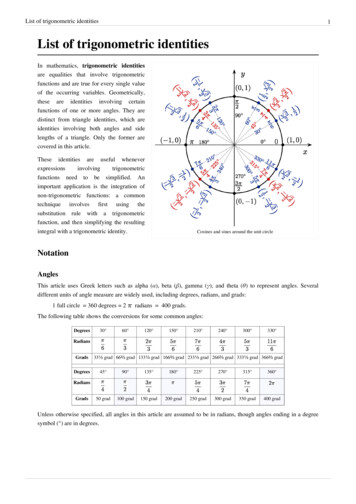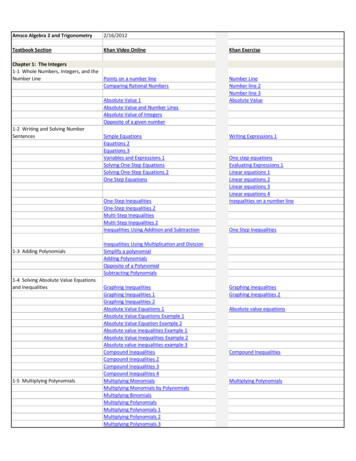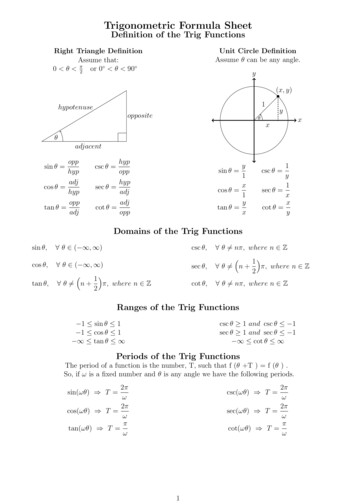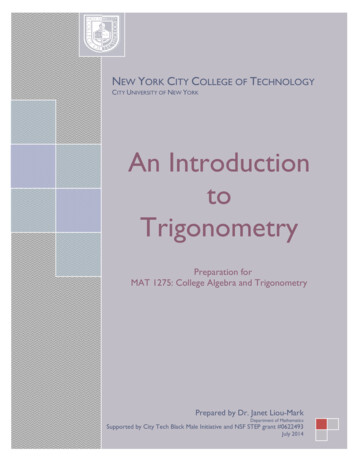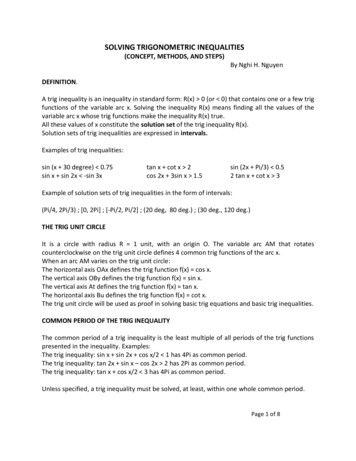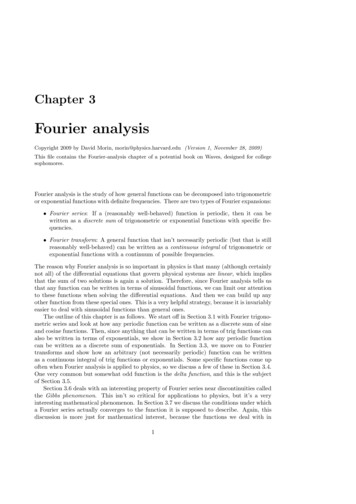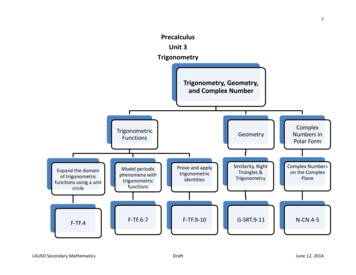
Transcription
a place of mindFA C U LT Y O F E D U C AT I O NDepartment ofCurriculum and PedagogyMathematicsTransformation onTrigonometric FunctionsScience and MathematicsEducation Research GroupSupported by UBC Teaching and Learning Enhancement Fund 2012-2014
Transformations onTrigonometric Functions
Summary of TransformationsVertical TranslationHorizontal Translationg ( x) f ( x ) kg ( x) f ( x k )k 0, translate upk 0, translate rightk 0 translate downk 0 translate leftReflection across x-axisReflection across y-axisg ( x) f ( x)g ( x) f ( x)y-values change signx-values change signVertical stretchesg ( x) k f ( x)Horizontal stretches x g ( x) f k k 1, expansionk 1, expansion0 k 1 compression0 k 1 compression
Standard FunctionsYou should be comfortable with sketching the following functions by hand:f ( x) sin( x) 2 0 f ( x) cos( x)2 2 0 f ( x) tan(x)2 2 0 2
Transformations onTrigonometric FunctionsB.A.The function f ( x) sin( x)is phase shifted (translatedhorizontally) by 2π.Which graph shows thistranslation? 2 0 2 C. 2 0 2 2 0 2 D. 2 0 2
SolutionAnswer: AJustification: Since sin(x) is periodic with period 2π, shifting thesine curve by 2π left or right will not change the function.sin( x) sin( x 2 ) sin( x 2 ) 2 0 f ( x) sin( x)2 2 0 g ( x) sin( x 2 )2
Transformations onTrigonometric Functions IIThe function f ( x) cos( x) is phase shifted by kunits such that:g ( x) cos( x k ) sin( x)Which of the following is a possible value of k?f ( x) cos( x)g ( x) sin( x)2 A. k 3B. k C. k 2 D. k 2E. k 2 0 2 2 0 2
SolutionAnswer: C 2Justification: When translating right, the cosine graph must moveunits. When translating to the left, the cosine graph must move 32 units.3 2This explains the followingtrigonometric identities: 2 3 sin( x) cos( x ) cos( x )22f ( x) cos( x)g ( x) sin( x) 2 0 2 The values of k are therefore:3 k or k 22Only answer C gives a possiblevalue for k.
Transformations onTrigonometric Functions IIIThe function f ( x) sin( x) is phase shifted by kunits such that:g ( x) sin( x k ) cos( x)Which of the following is a possible value of k?f ( x) sin( x) 2 0 g ( x) cos( x)2 2 0 2 A. k 3B. k 23 C. k 25 D. k 27 E. k 22
SolutionAnswer: D3 2Justification: When translating right, the sine graph must moveunits. When translating to the left, the sine graph must move 2 units.3 2 Neither of these values agree withthe answers. Factors of 2π can beadded or subtracted to thesetranslations to reach the sameoutcome, since sine is periodicwith 2π. 5 k 2 2 5 22sin( x k ) cos( x)f ( x) sin( x)g ( x) cos( x) 2 02 2 5 sin( x ) cos( x)2
Transformations onTrigonometric Functions IVThe graph g (x) shows thefunction f ( x) cos( x) after ithas been phase shifted. Whichof the following is true?3 A. g ( x) cos( x )2B. g ( x) cos( x ) C. g ( x) cos( x )23 D. g ( x) cos( x )25 E. g ( x) cos( x )2g (x) 2 0 2
SolutionAnswer: DJustification: Find the first positive value where g ( x) 1 . This pointcan be used to determine how much the cosine graph has beentranslated. Since f (0) cos(0) 1,3 from the graph, we can see that2the point (0, 1) has moved (right)to ( 3 ,1 ) .2The correct formula is therefore:3 g ( x) cos( x )2Note: If we instead shift left, anequivalent answer is:f (x)g (x) 2 0 2 g ( x) cos( x )2
Transformations onTrigonometric Functions VThe graph g (x) shows thefunction f ( x) tan(x) after ithas been reflected. Acrosswhich axis has it beenreflected?g (x)A. x-axis onlyB. y-axis onlyC. x-axis or y-axisD. x-axis and y-axisE. Neither x-axis or y-axis 2 0 2
SolutionAnswer: CJustification: Since f ( x) tan(x) is an odd function, a reflectionacross the x-axis and a reflection across the y-axis are the same.Recall that for odd functions f ( x) f ( x) .Reflection inx or y-axis 2 0 2 2 0 2
Solution ContinuedAnswer: CJustification: If we reflect f ( x) tan(x) in both the x-axis and yaxis, we would get the tangent function again. This is not the sameas the graph g(x).g (x)f ( x) tan(x) tan( x)Reflection inx or y-axis 2 Reflection inx and y-axis0 2 2 0 2
Transformations onTrigonometric Functions VIB.A.f ( x) sin( x) has beendisplaced vertically such thatg ( x) sin( x) 1.Which graph shows g (x) ? 2 0 2 C. 2 0 2 2 0 2 D. 2 0 2
SolutionAnswer: BJustification: The transformation g ( x) sin( x) 1 shifts the graphvertically upwards by 1 unit. This eliminates answers C and D, whichboth represent downward shifts. Since f ( x) sin( x) spans between-1 and 1, we should expect g to span between 0 and 2.f ( x) sin( x) 1 sin( x) 1 1 1 sin( x) 1 1 10 sin( x) 1 2g ( x) sin( x) 1 2 0 2 2 0 2
Transformations onTrigonometric Functions VIIThe amplitude of a periodicfunction is half the differencebetween its maximum andminimum values.What is the amplitude off ( x) 2 cos( x) ?A. 8B. 4C. 2D. 1E. 0 2 0 2
SolutionAnswer: CJustification: From the graph of g ( x) 2 cos( x) , we can see themaximum value is 2 and the minimum value is -2.Half the difference between themaximum and minimum is:g ( x) 2 cos( x)M m where A amplitude2M maximum2 ( 2 )m minimum 2 2A 2 0 2
Transformations onTrigonometric Functions VIIIWhat is the amplitude of f ( x) a cos( x) , where a 0 ?A. 2aB. aC. 0D. aE. Cannot be determiend
SolutionAnswer: DJustification: The amplitude of f ( x) a cos( x) is calculated asshown:2a2aM ma 0a 0A aa2a ( a )00 2 a a a 2a 2 0 2 2a 2 0 2 The two graphs above show that the maximum and minimum valuesof f ( x) a cos( x) are a and a respectively. The amplitudecannot be negative.
Transformations onTrigonometric Functions IXThe function f ( x) cos( x) isvertically expanded and displacedso that g ( x) p cos( x) q . If 6 g ( x) 2,what are the values of p and q?A. p 4, q 2B. p 4, q 2C. p 8, q 4D. p 8, q 2E.p 8, q 2 2 0 2
SolutionAnswer: AJustification: We are given that 6 g ( x) . 2 , so its maximumvalue is 2 and its minimum is -6. We can calculate the amplitude:A M m 2 ( 6) 422Vertical displacement does not change the shape of the graph,therefore it does not impact amplitude.We can determine that 4cos(x) spans between -4 and 4 using whatwe learned from the previous question. In order to change the maxvalue from 4 to 2 (or the min from -4 to -6), we must shift thefunction down by 2 units:g ( x) 4 cos( x) 2 4 4 cos( x) 4Translate 2 units down 6 4 cos( x) 2 2p 4, q 2
Transformations onTrigonometric Functions X 1 g(x) sin x ?What is the period of the function 2 Press for hint 1 g ( x) sin x 2 A. 4B. 2C. 2 D. E. 2 2 0 2
SolutionAnswer: DJustification: The function g(x)shows the graph sin(x) after ithas been horizontallycompressed by a factor of 0.5. 1 g ( x) sin x 2 We should expect the period ofg(x) to be compressed by thesame factor. Since the period ofsin(x) is 2π, the period ofsin(0.5x) is π.1 period 1 period 1 period 1 period 2 0 2
Transformations onTrigonometric Functions XIWhat is the period of the function g ( x) a tan(bx c) d , a 0?A. 2b B. b C. bb D.2E. bThe period of the tangent function f ( x) tan(x)is π.Press for hint
SolutionAnswer: EJustification: Recall that horizontal stretches by a factor of kresults in substituting x with x k .Since g ( x) a tan(bx c) d has been horizontally stretched by afactor of 1 b and the period of tan(x) is π, the period of g is .bNotice that the vertical stretch by the factor of a does not affect theperiod of the function. The vertical displacement by d units andphase shift by c units do not change the shape of a function, sothey also do not affect the period of the function. The period of thesine, cosine, and tangent functions are only dependant on thehorizontal stretch, b.
Transformations onTrigonometric Functions XIIThe graph of g ( x) sin(bx) isshown to the right. What isthe value of b?Pay attention to the values onthe x-axis.A. b 2 B. b C. b 22D. b 1E. b 2 g ( x) sin(bx)
SolutionAnswer: AJustification: The period of the function shown in the graph is 1.The period of g ( x) sin(bx) is 2 b . (Review the solution to theprevious question, except using sin(x) rather than tan(x).We can solve for b to find by solving:2 1bb 2 The graph has been horizontallycompressed by a factor of 1 2 .g ( x) sin(2 x)
Transformations onTrigonometric Functions XIIIThe function g ( x) a tan(0.5x)is shown to the right. What is theapproximate value of a?A. 8 a 10B. 6 a 8C. 4 a 6D. 2 a 4E. 0 a 2 PressThereexistsfora hint tan 1 4 value x p where g ( p) a.a tan a 4 g ( x) a tan(0.5x) 20 2
SolutionAnswer: C tan 1Justification: Recall that 4 g(x) 5·tan(0.5x) , 5 2 A tangent function that has beenhorizontally expanded by 2 will equalone at 2 , rather than 4 . x g x a tan Let x 2 2 1 , 1 2 g a tan a 2 2 2 f(x) tan(0.5x)1 From the graph, g a 5 . 2 20 2Points whose y-values are 1 before being vertically stretched reveal theexpansion or compression factor.
Transformation on Trigonometric Functions Science and Mathematics Education Research Group Supported by UBC Teaching and Learning Enhancement Fund 2012-2014 Department of Curriculum and Pedagogy a place of mind F A C U L T Y O F E D U C A T I O N . Transformations on Trigonometric Fu
